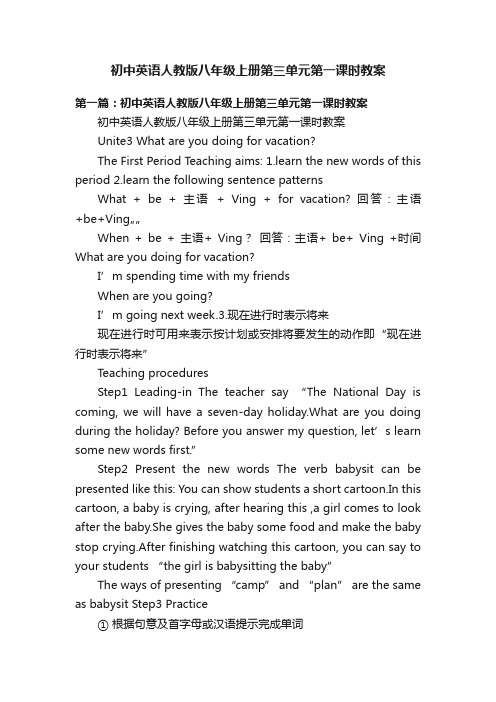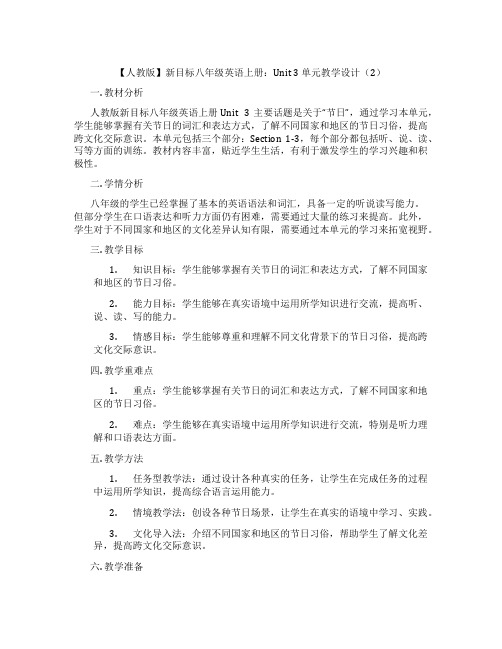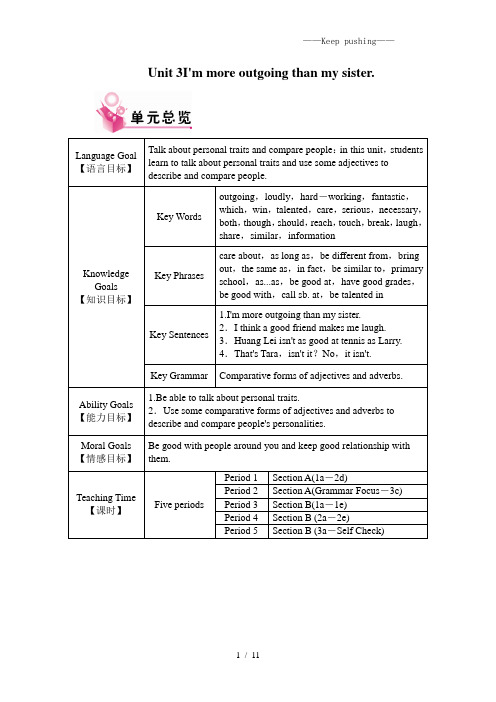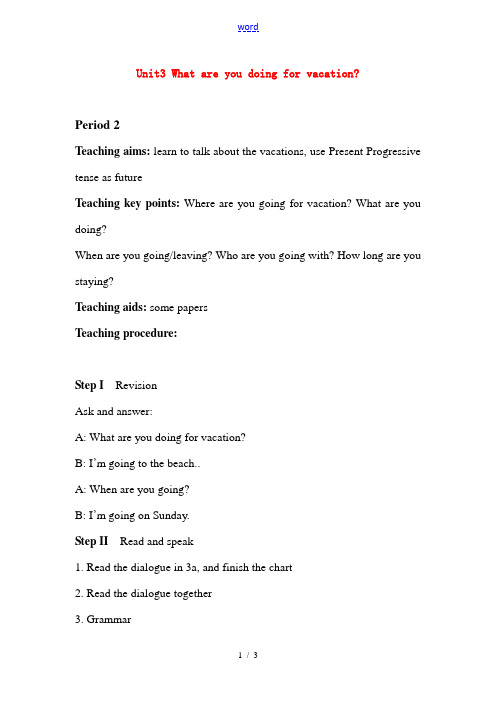人教版的八年级英语上册第三单元教案设计
初中英语人教版八年级上册第三单元第一课时教案

初中英语人教版八年级上册第三单元第一课时教案第一篇:初中英语人教版八年级上册第三单元第一课时教案初中英语人教版八年级上册第三单元第一课时教案Unite3 What are you doing for vacation?The First Period T eaching aims: 1.learn the new words of this period 2.learn the following sentence patternsWhat + be + 主语+ Ving + for vacation? 回答:主语+be+Ving……When + be + 主语+ Ving?回答:主语+ be+ Ving +时间What are you doing for vacation?I’m spending time with my friendsWhen are you going?I’m going next week.3.现在进行时表示将来现在进行时可用来表示按计划或安排将要发生的动作即“现在进行时表示将来”Teaching proceduresStep1 Leading-in The teacher say “The National Day is coming, we will have a seven-day holiday.What are you doing during the holiday? Before you answer my question, let’s learn some new words first.”Step2 Present the new words The verb babysit can be presented like this: You can show students a short cartoon.In this cartoon, a baby is crying, after hearing this ,a girl comes to look after the baby.She gives the baby some food and make the baby stop crying.After finishing watching this cartoon, you can say to your students “the girl is babysitting the baby”The ways of presenting “camp” and “plan” are the same as babysit Step3 Practice① 根据句意及首字母或汉语提示完成单词1.Jack has to b_____his sister’s baby on Saturday2.He p_____to have a relaxing vacation3.I’m going_____(宿营)with my classmates.②让学生自己用这三个词造句Step4 1a①Ask students to look at the picture in 1a,and have students work in groups of four to discuss and finish it.②Correct the answersStep5 1b ①Display the wall calendar and present the expression: what are you doing for vacation? I’m staying home on Sunday.②let students listen to the recording and ask them to write a conversation number from 1 to 3 in each box.③Check the answersStep6 1c ①Read the sample dialogue in 1c to students ②let students do the pairwork ③let students perform the dialogue in class in different moods such as happy, irritated,bored or in different role relationships such as a parent and child, husband and wife, two friends,etc.④let students ask and answer the questions about the people in the pictureStep7 2a.2b First ask the students to look at the chart.Make them understand the listening task carefully.Second let students predict the content of the listening task, according to the information that the task has given.Third paly the recording for the first time ,point out the sample.Hector is visiting his cousins on Friday.For the second time, let students finish the filling task.Step8 2c ①Ask two students to read the dialogue ②Have students to ask and answer in pairs ③let students talk about their vacation plans④Ask some pairs to say their conversations to the class.Step9 Grammar Focus Review the grammar box①What + be + 主语 + Ving + for vacation?回答:主语+be+Ving……What are you doing for vacation? I am visiting my grandmother What is she doing for vacation? She is going camping What are they doing for vacation? They are relaxing at home When + be + 主语+ Ving 回答:主语+ be+ Ving +时间When are you going? I am going on MondaythWhen is he going? He is going on the 12.When are they going? They are going next week.②解释一下,现在进行时可用来表示按计划或安排将要发生的动作。
人教版八年级英语上册Unit3教学案

人教版八年级英语上册Unit3教学案Unit 3 Section A 1a-1c【Learning objectives】Knowing : 本课的2个单词和8个短语。
Habit----forming: --- A: What are you doing for vacation?---B: I'm babysitting my sister.Practising: 熟练运用本课词汇和句型谈论将来要进行的活动。
.【Important points】利用本课句型谈论自己和朋友的假期活动计划。
【Learning process】(教师寄语: Practice makes perfect)一、自主学习(教师寄语: No pains, no gains)Task 1. 学习1a:掌握本课重点单词和短语单词:临时照顾(小孩)露宿,野营短语:1、拜访你的朋友_______________2、照顾我的妹妹________________3、和朋友一起度过_______________4、在家里放松__________________5、做运动6、举行音乐会7、打篮球8、去野营Task 2. 学习1b,听听力。
1、听录音选出所听到的词与短语a. campb. babysit my sisterc. visit my grandmotherd. relax at homee. spend time with my friends2、再听一遍,完成课本表格。
3、理解下列询问假期将要干什么的句型,并仿照练习A:What are you doing for vacation? B: I'm camping for vacation.A:What is she doing for vacation? B: She is visiting her grandmother.讲解:1、“What are you doing for vacation”时一个现在进行时的句子,但表示的却是将来,意味着动作马上就要发生。
【人教版】新目标八年级英语上册:Unit 3 单元教学设计(2)

【人教版】新目标八年级英语上册:Unit 3 单元教学设计(2)一. 教材分析人教版新目标八年级英语上册Unit 3主要话题是关于“节日”,通过学习本单元,学生能够掌握有关节日的词汇和表达方式,了解不同国家和地区的节日习俗,提高跨文化交际意识。
本单元包括三个部分:Section 1-3,每个部分都包括听、说、读、写等方面的训练。
教材内容丰富,贴近学生生活,有利于激发学生的学习兴趣和积极性。
二. 学情分析八年级的学生已经掌握了基本的英语语法和词汇,具备一定的听说读写能力。
但部分学生在口语表达和听力方面仍有困难,需要通过大量的练习来提高。
此外,学生对于不同国家和地区的文化差异认知有限,需要通过本单元的学习来拓宽视野。
三. 教学目标1.知识目标:学生能够掌握有关节日的词汇和表达方式,了解不同国家和地区的节日习俗。
2.能力目标:学生能够在真实语境中运用所学知识进行交流,提高听、说、读、写的能力。
3.情感目标:学生能够尊重和理解不同文化背景下的节日习俗,提高跨文化交际意识。
四. 教学重难点1.重点:学生能够掌握有关节日的词汇和表达方式,了解不同国家和地区的节日习俗。
2.难点:学生能够在真实语境中运用所学知识进行交流,特别是听力理解和口语表达方面。
五. 教学方法1.任务型教学法:通过设计各种真实的任务,让学生在完成任务的过程中运用所学知识,提高综合语言运用能力。
2.情境教学法:创设各种节日场景,让学生在真实的语境中学习、实践。
3.文化导入法:介绍不同国家和地区的节日习俗,帮助学生了解文化差异,提高跨文化交际意识。
六. 教学准备1.教师准备:准备好与节日相关的图片、视频、音频等教学资源,以及练习题和作业。
2.学生准备:学生提前预习课文,了解本单元话题。
七. 教学过程1.导入(5分钟)教师通过展示不同节日的图片,如春节、圣诞节、中秋节等,引导学生谈论各自喜欢的节日,激发学生的学习兴趣。
2.呈现(10分钟)教师播放教材中的听力材料,要求学生听后回答相关问题。
人教版初中英语八年级上册Unit 3 教案

Unit 3I'm more outgoing than my sister.Section A是基本的语言部分,打好本单元目标语言的基础。
运用听力(1b,2a,2b)、pair-work(1c,2c)、role-play (2d)等口语练习活动,层层递进,步步深入,充分培养学生学习目标英语的语感。
目标语言(语法和词汇)是在每个单元的开始通过图片和对话框呈现的。
图片将帮助学生建立一个自然的语境,让学生清晰地理解新的语言目标,熟悉这些语言在日常生活中是怎样使用的。
Section B是比较级的拓展和综合的语言运用。
1a,1b通过讨论在朋友身上什么是最重要的,为后面提供基本句子如makes me laugh等。
1c,1d通过听力继续以朋友为话题以比较级为语法谈论朋友。
2b,3c是通过阅读和写作最后达到综合运用语言的目的,2b培养真实生活中的语言阅读技能。
4通过谈论谁是合适的student helper来继续巩固运用目标语言。
Self Check 2考查五个形容词的用法及区别形容词比较级与原级的使用。
Self Check 3运用比较级对比自己和好友。
第一课时Section A(1a-2d)Teaching Goals【教学目标】Key words:outgoing,better,loudly,quietly,hard-working,competition,fantastic,which,clearly,winKey phrases:play the drums,more...than,as...as,singing competition,have funKey sentences:1.I'm more outgoing than my sister.2. That's Tara,isn't it?No,it isn't.3. I think she sang more clearly than Nelly.Teaching Key Points【教学重点】The vocabulary:outgoing,better,loudly,quietly,hard-working,competition,fantastic,which,clearly,win,more...than,as...asTarget language:,that's Tom.Sam has longer hair than Tom.—That's Tara,isn't it?—No,it isn't.It's Tina.Tina is taller than Tara.And she also sings more loudly than Tara.—Did you like the singing competition yesterday,Anna?—Oh,it was fantastic!Nelly sang so well!Is Tom smarter than Sam?Teaching Difficult Points【教学难点】Oral practice using the target language above.Teaching Aids【教学工具】An English textbook,a tape recorder,CAI or courseware.Teaching Steps【教学过程】★Step 1Leading inAsk a student to introduce herself/himself.★Step 2Pre-taskPage 17,1a.1.Show some pictures to Ss.Say,They are stars.Ask Ss to tell what they see.Ask Ss to use the words:tall,loudly,thin,long hair,short hair,heavy,quietly,short and so on.2.Then ask Ss to repeat these sentences:Yao Ming is taller than Ronaldo.★Step 3While-taskPage 17,1c & 1b.1.Call attention to the picture.2.Point out the sample conversation in Activity 1c.Say,Now work with a partner.Make your own conversation about the twins.3.Ask several pairs to say one or more of their conversations.4.Then listen to the recording.Ask Ss to number the twins.5.Check the answers.Page 18,2a.1.Point out the two columns and read the headings:-er,-ier and more.Then point out the words in the box.Read.Say,Now listen and write the“-er”and“-ier”words in the first column and the words that use“more”in the second column.2.Play the recording and check the answers.Page 18,2b.1.Point out the picture and the two boxes with the headings Tina and Tara.Say,Listen to the recording.Write sentences in the boxes.2.Play the recording and check the answers.★Step 4Post-taskPage 18,2c & 2d.1.Point out the chart in Activity 2c and on Page 81.Say,Make your own conversations according to the information.Ask pairs to continue on their own.2.Correct the answers.3.Make students scan the conversation in 2d.4.Teach and then make Ss role-play the conversation in pairs.In this part,student A will be Julie.Student B will be Anna.As they talk,move around to monitor their work.Offer language or pronunciation support as needed.5.Have a group of students present their conversation to the class.★Step 5Homework1.How are you and your sister/brother different?Write down.2.Do the exercises on Page 15 in students' book.Board Design板书设计Unit 3I'm more outgoing than my sister.The first periodSection A(1a-2d)1.Words:outgoing,better,loudly,quietly,hard-working,competition,fantastic,which,win,clearly2.Target language:①A:That's Tara,isn't it?B:No,it isn't.②A:Is Tom smarter than Sam?B:No,he isn't.Sam is smarter than Tom.第二课时Section A(GF-3c)Teaching Goals【教学目标】Key sentences:1.Is Tara more outgoing than Tina?No,she isn't.Tina is more outgoing than Tara.2.Does Tara work as hard as Tina?Yes,she does.3.Who is smarter,your mother or your father?I think my mother is smarter than my father.Teaching Key Points【教学重点】1.Grammar Focus.The sentences in the box.2.The comparative forms of adjectives and adverbs.Teaching Difficult Points【教学难点】1.The comparative forms of adjectives and adverbs.2.Use some adjectives to describe people and use their comparative forms to compare people.Teaching Aids【教学工具】An English textbook,CAI or courseware.Teaching Steps【教学过程】★Step 1Leading inAsk,How are you and your mother/father different?Ask some Ss to answer.★Step 2Pre-taskPage 19,Grammar Focus.1.Review the grammar box.Ask Ss to read the sentences to the class.2.Write the phrases“more outgoing than”.Say,When you compare things using words with three or more syllables,you use the word “more”.3.Call attention to the word“friendly”,circle“y”and say,When a word ends in“y”,change“y”to an“i”and add“-er”.4.Practice reading the sentences in the chart.★Step 3While-taskPage 19,3a & 3b.1.Call students' attention to 3a.2.Make students complete the tasks individually.3.Choose Ss to give their answers.4.Correct the answers.5.Practice reading.6.Turn to 3b.And choose a student to answer the five questions according to the example.★Step 4Post-taskPage 19,3c.1.Ask students to read the sample conversation in the box.2.Have students work in pairs to complete the chart.3.Ask some pairs to present their dialogues.★Step 5Homework1.Compare one of your best friends with you.Write down the same and different things between you two.2.Do the exercises on Page 16 in students' book.Board Design板书设计Unit 3I'm more outgoing than my sister.The second periodSection A(GF-3c)1.Target language:①A:Is Tara more outgoing than Tina?B:No,she isn't.Tina is more outgoing than Tara.②A:Are you as friendly as your sister?B:No,I'm not.I'm friendlier.③A:Does Tara work as hard as Tina?B:Yes,she does.④A:Who is smarter,your mother or your father?B:I think my mother is smarter than my father.2.Answers to 3a.第三课时Section B(1a-1e)Teaching Goals【教学目标】Key words & phrases:talented,truly,care,be talented in,the same as,be good at,care about,make ughKey sentences:1.I think a good friend makes me laugh.2.Molly studies harder than her best friend.Teaching Key Points【教学重点】The vocabulary:talented,care,care about,be talented inTarget language:I think a good friend makes me laugh.For me,a good friend likes to do the same things as me.Yes,and a good friend is talented in music,too.That's not very important for me...Molly studies harder than her best friend.Well,Mary and her best friend are both tall.Teaching Difficult Points【教学难点】Use the target language to talk with your classmates about your opinions on what makes a good friend.Teaching Aids【教学工具】An English textbook,a tape recorder,CAI or courseware.Teaching Steps【教学过程】★Step 1Leading in1.Show a maxim to Ss:A friend in need is a friend indeed.2.Ask,What kinds of things are important in a friend?★Step 2Pre-taskPage 20,1a.1.Read each description to the class and ask the Ss to repeat.2.What kinds of things are important in a friend?Rank the things below 1—7(1 is the most important).3.Ask different Ss to copy the seven phrases on the board.Then read the phrases together.★Step 3While-taskPage 20,1b.1.Say,Now make your own statements about friends using the phrases in Activity 1a.2.Ask some Ss to tell the class what they look for in a friend.And say,Who is your best friend?Page 20,1c.Play the recording and check the answers.Page 20,1d.Play the recording and check the answers.★Step 4Post-taskPage 20,1e.1.Say,Now work with your partner.Make a conversation using information in the chart.2.Ask several pairs to say their conversations to the class.★Step 5HomeworkDo the exercises on Page 17 in students' book.Board Design板书设计Unit 3I'm more outgoing than my sister.The third periodSection B(1a-1e)1.Key vocabulary:truly,be talented in,the same as,be good at,care about,make ugh2.Target language:A:Molly studies harder than her best friend.B:Well,Mary and her best friend are both tall.第四课时Section B(2a-2e)Teaching Goals【教学目标】Key words:serious,mirror,kid,necessary,both,though,grade,should,saying,reach,hand,touch,heart,fact,break,arm,laugh,share,loud,similar Key phrases:as long as,be different from,bring out,the same as,care about,in fact,be similar toKey sentences:1.I'm quieter and more serious than most kids.2.I don't really care if my friends are the same as me or different.3.Huang Lei isn't as good at tennis as Larry.4.A true friend reaches for your hand and touches your heart.Teaching Key Points【教学重点】The vocabulary:serious,necessary,both,though,should,reach,touch,break,laugh,share,loud,similar,as long as,be different from,the same as,in fact,be similar toTarget language:I'm quieter and more serious than most kids.That's why I like reading books and study harder in class.In fact,she's funnier than anyone I know.I know she cares about me because she's always there to listen.Teaching Difficult Points【教学难点】Talk about the famous sayings about friends.Teaching Aids【教学工具】An English textbook,CAI or courseware.Teaching Steps【教学过程】★Step 1Leading in1.Greetings.2.Ask,Should friends be the same or different?Choose 2 or 3 students to talk about their opinions.Say,Today we'll read about what these people think.★Step 2Pre-taskPage 21,2a & 2b.1.Project some famous sayings about friendship on the screen.Ask Ss to guess their meanings and think of more.2.Project these new words on the screen or write them on the board and teach the new words.Ask students to repeat them.And make sure everyone knows the meanings.serious adj.严肃的;mirror n.镜子;necessary adj.必需的;both adj. & pron.两个;though adv.不过,可是conj.虽然;should modal v.应该;reach v.到达;touch v.感动,触摸;fact n.事实;break v.(使)破;laugh v.笑;share v.分享;similar adj.类似的;as long as只要;be different from 与……不同;bring out 使显现;the same as和……相同;in fact事实上;be similar to与……相像的3.Make students scan the three articles first.Ask students to put a mark in contents that are unfamiliar to them.Then the teacher lead Ss to learn them.Pay attention to the new words and phrases on the screen.4.Practice reading.★Step 3While-taskPage 22,2c & 2d.1.Make students read 2b again.Then judge if the eight statements in 2c are true(T)or false(F).2.Choose students to give their answers.3.Check the answers.4.Ask,How do you and your friends compare with the people in the article?Choose a student to talk about it with five sentences.★Step 4Post-taskPage 22,2e.1.Read the four sayings about friends.2.Talk about these questions with your partner:Which saying about friends is your favorite?Which friend do you think about when you read this saying?Why?Begin your statements according to the example:My favorite saying is...It makes me think about my best friend.She/He is...★Step 5Homework1.Search for five famous sayings about friends.Write them in your exercise books.2.Do the exercises on Page 18 in students' book.Board Design板书设计Unit 3I'm more outgoing than my sister.The fourth periodSection B(2a-2e)1.Words:serious,mirror,necessary,both,grade,should,saying,reach,hand,touch,fact,break,laugh,share,loud,similar2.Phrases:as long as,be different from,bring out,the same as,care about,in fact,be similar to3.Sentences:①I'm quieter and more serious than most kids.②Huang Lei isn't as good at tennis as Larry.③Friends are like books-you don't need a lot of them as long as they're good.④A true friend reaches for your hand and touches your heart.第五课时Section B(3a-Self Check)Teaching Goals【教学目标】Key words & phrases:primary,information,primary school,be good with,call sb.at,have good grades Key sentences:students.2.Call the English Study Center at 443-5667 for more information.3.So who do you think should get the job,Jenny or Jill?Teaching Key Points【教学重点】The vocabulary:information,primary school,have good grades,be good with,call sb.at...Teaching Difficult Points【教学难点】Writing practice.Teaching Aids【教学工具】An English textbook,CAI or courseware.Teaching Steps【教学过程】★Step 1Leading in1.Greetings.2.Check the homework.★Step 2Pre-taskPage 23,3a.1.Look at the pictures and the information in the chart.2.Compare Wang Lingling with Liu Lili.Write down the results.3.Choose a student to present his or her answers.★Step 3While-taskPage 23,3b & 3c.1.Complete the task in 3b.2.Write two paragraphs describing your friends using the notes you make in 3b.3.Choose 2 or 3 students to read their competitions loudly.4.Correct the mistakes.★Step 4Post-taskPage 24,Part 4.1.Write the names of two outgoing students on the board.Say,Who do you think should get the job,A or B?2.Ask Ss to work in pairs.3.Ask some pairs who they think should get the job and why.★Step 5ExercisePage 24,Self Check.1.Ask students to work on their own.2.Check the answers.★Step 6Homework1.Compare two of your best friends.Write five sentences using comparatives.2.Do the exercises on Page 19 in students' book.Board Design板书设计Unit 3I'm more outgoing than my sister.The fifth periodSection B(3a-Self Check)1.Key vocabulary:information,primary school,be good with,call sb.at+电话号码,have good grades2.Sentences:①Call the English Study Center at 443-5667 for more information.②Jenny is smarter,but I think Jill is more outgoing.11 / 11。
新人教版八年级英语上册Unit3 教案

新人教版八年级英语上册Unit3 教案本教案针对新人教版八年级英语上册Unit3的教学内容。
该单元主要包含以下两大话题:1)时间和频率表达方式;2)日常活动及其规划。
通过教学,学生将能够熟练运用常用的时间和频率表达方式,并能够描述日常活动并做出相应的规划安排。
1.能够运用常见的时间和频率表达方式,如days of the week。
months of the year。
at。
on。
in。
every等;2.能够描述日常活动,并能够就日常活动做出规划安排;3.能够流利地使用所学词汇和句型进行交流。
1.时间和频率表达方式的准确运用;2.描述日常活动的基本句型的运用。
第一课时1.教授并练days of the week;2.学生进行日常活动的描述和规划。
1.复并巩固days of the week;2.教授并练months of the year;3.学生进行月份与日常活动的搭配练。
1.复并巩固days of the week和months of the year;2.教授并练at。
on。
in等时间表达方式;3.学生进行日常活动时间的描述练。
1.复并巩固时间表达方式;2.教授并练every的用法;3.学生进行日常活动规划的练。
1.情境教学法:通过创设真实的情境,让学生在实际生活中应用所学知识;2.合作研究法:通过小组合作研究,鼓励学生相互交流和合作,提高研究效果;3.游戏教学法:通过游戏形式激发学生的兴趣,提高研究积极性。
1.针对每一课时的研究内容,设计相应的练题进行评估;2.利用小组活动和教师提问的方式进行课堂实时评估;3.通过学生的作业和考试成绩,对研究效果进行总体评估。
1.教材:新人教版八年级英语上册Unit3;2.多媒体设备:投影仪、音响等;3.黑板和白板笔。
通过教材分析,我将采用情境教学法、合作研究法和游戏教学法等多种教学方法,来激发学生研究的兴趣,提高研究效果。
同时,将充分利用教学资源,使课堂内容更加生动有趣。
八年级英语上第三单元教案人教版

Unit3 What are you doing for vacation?Period 2Teaching aims: learn to talk about the vacations, use Present Progressive tense as futureTeaching key points: Where are you going for vacation? What are you doing?When are you going/leaving? Who are you going with? How long are you staying?Teaching aids: some papersTeaching procedure:Step I RevisionAsk and answer:A: What are you doing for vacation?B: I’m going to the beach..A: When are you going?B: I’m going on Sunday.Step II Read and speak1. Read the dialogue in 3a, and finish the chart2. Read the dialogue together3. Grammar●forfor three days for a week for two months●send sth to sb / send sb sthe.g. He sent me a letter last week. / He sent a letter to me lastweek.give sb sth show sb sthgive sth to sb show sth to sb4. Role playMake the dialogue between the girls and the boys5. PairworkStep III Vacation dreams1.Write down your dream vacations on a paper, according to thequestions below:1)Where are you going for vacation?2)What are you doing there?3)When are you going/leaving?4)Who are you going with?5)How long are you staying?Example: I’m going to Hawaii for vacation. I’m leaving this weekend with my best friend. We are swimming in the sea, lying on the beach and having some seafood. We are staying there for about two weeks. We are sure we can have a relaxing vacation.2.Procedure:StudentA stands up and tell the class about his dream vacation. Then the teacher can ask the others some questions like: what is he doing for vacation? Where’s going?…or the other students can ask teacher some questions.Step IV Homework1)Finish the exercise book 12)Write a vacation plan课后点评:1)整节课思路清晰,衔接连贯,课堂气氛活跃,达到了很好的教学效果。
八年级上册英语第三单元教案优秀5篇

八年级上册英语第三单元教案优秀5篇八年级上册英语第三单元教案篇1一、教学目标:1.语言知识目标:1)学习掌握下列词汇:copy, return2)进行一步复习巩固学习Section A部分所学的生词和词组。
3)对询问困难及提出的建议的句型,掌握其规则。
4)通过不同方式的练习,来熟练运用询问及提建议的表达方式。
2.情感态度价值观目标:让学生了解每个人在生活中都有可能遇到一些挫折和不幸,我们多去向那些不幸和困难的人们多表示自己的爱心,多去理解和帮助他们,多向他们提出解决问题的建议而不是去嘲笑他们。
二、教学重难点言1.教学重点:1)复习巩固Section A部分所学的生词和词组,达到熟练运用的目标。
2)熟练掌握和运用询问困难和提建议的表达方式。
2.教学难点:1) 总结询问问题和提出建议的句型,掌握规则。
2)练习运用所学的句型。
三、教学过程Step 1 Warming- up and revision1. Have a dictation of the new words learned in the last class.make sth. clear (同义词) ___________talk (同义词) _______________not allow (同义词) ______________worried (同义词) ______________get along with (同义词) ____________communicate (名词)_____________old (比较级) _______________2. Check the homework.3. Let some Ss read the article in 3a. Then finish the short passage about Sad and Thirteen. (见课件)1. Sad and Thirteen has some _________. He can’t __________his family. His parents _____ a lot. It’s the only _____________ they have. When they _____, it’s like a big black cloud ____________their home. He doesn’t like it.His brother always watches whatever he wants until midnight. He _______ to let him watch his favorite TV show. So He always feels ______ and ________ at home.2. Robert Hunt thinks Sad and Thirteen should _________ these feelings to his family. He should ____ to help. Maybe he _________ _____ jobs around the house so that they have more time _______________________. Second, he could sit down and ____________ ____ his brother. He could ________ that he _________ him watching TV all the time, however, he should let him watch his _____________.八年级上册英语第三单元教案篇2【学习目标】1.学生能掌握六个频率副词的用法。
八年级英语上册-人教版-Unit 3 教学设计(1)

八年级英语上册-人教版-Unit 3 教学设计(1)一. 教材分析人教版八年级英语上册Unit 3的主题是“How do you get to school?”,主要让学生掌握常用的交通工具名称及表达方式,学会用一般现在时询问和回答别人是如何去学校的。
本单元还包括了听力、阅读、写作和语法等方面的内容,旨在全面提高学生的英语综合运用能力。
二. 学情分析八年级的学生已经掌握了基本的英语语法和词汇,具备一定的听、说、读、写能力。
但是,部分学生对一些复杂的情态动词短语和一般现在时的用法还不够熟练,需要通过本节课的教学来进一步巩固。
三. 教学目标1.能够听懂、会说、会读、会写本课的生词和短语。
2.能够用一般现在时询问和回答别人是如何去学校的。
3.能够熟练运用情态动词短语和一般现在时进行简单的交流。
4.提高学生的听力、口语、阅读和写作能力。
四. 教学重难点1.重点:掌握本课的生词和短语,学会用一般现在时询问和回答别人是如何去学校的。
2.难点:熟练运用情态动词短语和一般现在时进行交流。
五. 教学方法1.任务型教学法:通过完成各种任务,让学生在实践中学习和运用英语。
2.情境教学法:创设真实的情境,让学生在实际生活中运用英语。
3.交际法:鼓励学生积极参与课堂交际活动,提高口语表达能力。
六. 教学准备1.教材:人教版八年级英语上册Unit 3。
2.多媒体设备:电脑、投影仪、音响等。
3.教学课件:根据教学内容设计的课件。
4.学生活动材料:单词卡片、练习册等。
七. 教学过程1.导入(5分钟)利用课件展示一些交通工具的图片,引导学生谈论他们平时是如何去学校的。
2.呈现(5分钟)老师分别扮演不同的角色,用一般现在时询问和回答别人是如何去学校的,如:“How do you get to school?”“I usually go to school by bus.”等。
同时,板书生词和短语,如:bus, trn, usually, walk等。
- 1、下载文档前请自行甄别文档内容的完整性,平台不提供额外的编辑、内容补充、找答案等附加服务。
- 2、"仅部分预览"的文档,不可在线预览部分如存在完整性等问题,可反馈申请退款(可完整预览的文档不适用该条件!)。
- 3、如文档侵犯您的权益,请联系客服反馈,我们会尽快为您处理(人工客服工作时间:9:00-18:30)。
Unit 3 I’m more outgoing than my sister.Period 1 Section A 1a-2d教学目标:一、知识目标1.Words andexpressions:outgoing,better,loudly,quietly,which,competition,fantastic,hard-working, clearly,win,funny,friendly,smart,lazy,Both...and,as...as... ,Singing,competition.2.Sentences:1)That’s Tara, isn’t it?2)She also sings more loudly than Tara.3)he most important thing is to learn something new and have fun.4)Nelly danced better than Lisa.二、能力目标1、学会对比表达,初步培养学生的语言综合运用能力。
2、掌握形容词副词比较级的用法。
三、情感目标逐步培养学生的逻辑表达能力,使学生相互了解,增强人际交往,以形成良好的人际关系。
四、语法难点形容词副词的比较级用法。
教学过程:Step 1 Presentation1.Ask the students to compare two objects by height /weight and so on.2.List some adjectives and their comparatives:good-better funny-morefunnier outgoing-more outgoing:and make a sentence like ,She speaksEnglish better than me.3.Let the students make sentences with the words above.Step 2 1a1.Learn new words:outgoing,better loudly quietly which competitionfantastic hard-working clearly win funny friendly smart lazy.2.look at the picture in 1a and make a list of the adjectives.Step 3 1b listen and write the number of the pairs.1.Listen again for the students to listen and fill in the chart.2.Check the answers with the class.Step 4 2a 2b Listening1.Listen and change the adjectives into comparatives by -er/ier/or more.2. Listen again and say:How are Tina and Tara different ?3. Pay attention to: more outgoing,as...as....Step 5 2c Pairwork:Fill in the chart first and then make conversations in pairs.Step 6 2d Role-play the conversations1.Let the students read the chart and find out the differences between Sam and Tom.2.Explain the comparatives of the adjectives:1) smart-smarter2) funny-funnier3) hardworking-more hardworking3.Let the students have five minutes for the students to recite the statements.4.Role-play the conversation in pairs.Step 7 TestFill in the blanks with the correct forms of the words given.1.Tom is _________ (friendly) than Sam.2.Jodie runs _________ (fast) than Tony.3.He works as __________ (hard) as his twin brother.教学反思:Unit 3 I’m more outgoing than my sister.Period 2 Section A Grammar Focus-Section B 1e教学目标:一、知识目标1.Words and expressions: hard-working,competition,fantastic,which,clearly,win,Talented,truly,care,care about.2.Key structure:1)This is longer than that.2)He sings better than his brother.3)Her mother is tall.4)Her dad is short.二、能力目标1.学会对比表达,初步培养学生的语言综合运用能力。
2.掌握形容词副词比较级的用法。
三、情感目标通过讨论生活细节活动的频率,让学生形成健康的生活理念形成积极向上的生活观。
四、语法难点频率副词的用法。
教学过程:Step 1 Revision 写出下面形容词的比较级形式:white,young,funny,red,west,cloudy,green,windy,happy,blue,curly,busy,y ellow,straight,sorry,big,tall,scary,small,hot,warm,short,cold,strict, long,cool,cheap,terrible,fantastic,colorful,successful,unfriendly,tired,surprised,delicious,relaxed,inte rnational,expensive,sunny.Step 2 New words:1. Learn the new words: hard-working,competition,fantastic,which,clearly,win,talented,truly,care,care about.2.Explain the use of them.Step 3 Grammar FocusLet the students read the sentences in the box and make sure they understand them.Pay attention to the use of the following sentences:1)Is Tom smarter than Sam?2)Is Tina more outgoing than Tina?3)Are you as friendly as your sister?4)Does Tina work as hard as Tara?5)Who’s more hard-working at school?要点总结:形容词在句中常作表语和定语,也可补充说明宾语;副词的句中主要作状语。
1.无需比较时,用原级。
或两者比较表示双方在程度、性质、特征等某方面相等时,用原级as-----as : Xiao Wang is as tall as Xiao Liu.This building looks not so(as)high as that one.2.两者比较,一方比另一方更------,用比较级:比较级+than3.要注意比较级的特殊变化和用more /less +原级表示比较的词。
Step 4 3a1.Let the students fill in the blanks in the box.2. Check the answers.Step 5 3b1.Think of yourself two years ago.2.Write about how you are different now.Step 6 3c Practice Fill in the chart.Step 7 Section B 1a 1b Discuss what is important in a good friend. Step 8 Listening 1c 1d1.Read the listening material first and then listen twice for each part.2.Check the answers.Step 9 Test1. My brother is two years __________(old)than me.2. Tom is as ________(fat) as Jim.3. Is your sister __________(young) than you? Yes, she is.4. Who is ___________(thin),you or Helen? Helen is.5. Whose pencil-box is __________(big),yours or hers? Hers is.6. Mary’s hair is as __________(long) as Lucy’ s.7.Ben ______ (jump) ________ (high) than some of the boys in his class.8.______ Nancy sing __________ (well) than Helen? Yes, she _____.9.Fangfang is not as _________ (tall) as the other girls.10.My eyes are __________(big) than ________ (she).教学反思:Unit 3 I’m more outgoing than my sister.Period 3 Section B 2a-2b教学目标:一、知识目标1.Words and expressions:be different from,both,bringout,grade,should,the same as,saying,reach,hand ,touch.2.Sentences:1)My mother told me a good friend is like a mirror.2)I’m quieter and more serious than most kids.3)We enjoy studying together.4)It’s not necessary to be the same .5)I always get better grades than he does.6)I don’t really care if my friends are the same as me or different.7)A true friend reaches for your hand and touches your heart.8)She made me laugh and feel better.二、能力目标:1.学会对比表达,初步培养学生的语言综合运用能力。
